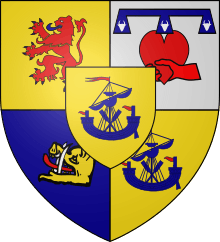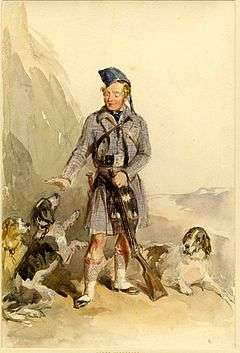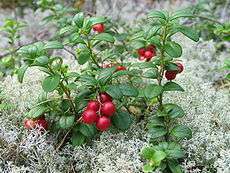Clan Chattan

Clan Chattan is a Highland Scottish clan.[1] The clan is unique in highland clan history in that it was a community or confederation,[2] of twelve separate Scottish clans,[3] who each had their own clan chief recognized under Scottish law, but who were united under and bound to a superior chief of the confederation for mutual solidarity, sustenance and protection in the Middle Ages and early modern period in the Scottish Highlands.
Origins
There is a theory that the name Chattan came from the Catti who were a tribe of Gauls who had been driven out by the Romans.[1] Another theory is that the name comes from Catav in Sutherland.[1] The most widely accepted theory is that they descended from Gillichattan Mor who was the great servant of Saint Cathan.[1] Gillichattan is believed to have been the co-arb or bailie of the abbey lands of Ardchattan.[1]
In the time of Malcolm II of Scotland the Clan Chattan possessed the lands of Glenloy and Loch Arkaig.[1] It was here that Tor Castle became the clan chief's seat.[1] Not much is certain about the history of the clan until towards the end of the 13th century.[1] Eva, daughter of Gilpatric or Dougal Dall, 6th chief of Clan Chattan in Lochaber married Angus Mackintosh, 6th chief of the Clan Mackintosh in 1291.[1] Thus Angus Mackintosh became 7th chief of Clan Chattan.[4] They lived together at Tor Castle before withdrawing to Rothiemurchus due to the enmity of Aonghus Óg of Islay, chief of Clan Donald.[1] As a result, the lands at Arkaig were occupied by the Clan Cameron who claimed that they had been abandoned.[1] This was the beginning of a long and bitter feud that was fought between the Clan Chattan and Clan Cameron until 1666.[1]
Clans belonging to Clan Chattan
.jpg)
Prior to the 14th century the Clan Chattan was a conventional Scottish clan.[1] However it evolved into an alliance or confederation of clans which was made up firstly of the descendants of the original clan (Clan Cattanach, Clan Macpherson, Clan MacBean (or McBain), Clan MacPhail), secondly of the Clan Mackintosh and their cadet branches (Clan Shaw, Clan Farquharson, the Ritchies, and Clan MacThomas) and thirdly of families who were not originally related by blood (Clan MacGillivray, Clan Davidson, the Macleans of Dochgarroch, Clan Macqueen, the Macintyres of Badenoch and the Clan Macandrews).[1]
Skene, however, gives a different version of how Clan Chattan was formed prior to the Mackintosh alliance.[5] Clan Vuirich (Clan MacPherson) and Clan Day (Clan Davidson) were the original co-founders and referred to as old Clan Chattan.[5] Added to these were six "stranger septs" who took protection from the clan.[5] These were Clan Vic Ghillevray (Clan MacGillivray), the Clan Yean (Clan MacBean), the Clan Vic Govies, the Clan Tarrel, the Clan Cheanduy, and the Sliochd Gowchruim or Smiths.[5]
According to Clan Chattan Association of the UK, clans that currently make up the Clan Chattan Association are as follows:[6]
- Clan Davidson
- Clan Farquharson
- Clan MacBean
- Clan MacGillivray
- Clan MacIntyre of Badenoch
- Clan Mackintosh
- Clan MacLean of Dochgarroch (the Macleans of the North)
- Clan MacPhail
- Clan Macpherson
- Clan Macqueen
- Clan MacThomas
- Clan Shaw of Tordarroch
Chiefs
The following is a list of the traditional chiefs of the Clan Chattan before marriage between Eva, heiress of Clan Chattan, with the Chief of Clan Mackintosh, through whose marriage a new line of Mackintosh Captains (Chiefs) of Clan Chattan was created :[4] See: Chiefs of Clan Mackintosh for later chiefs of Clan Chattan. In 1942, the Lyon Court separated the leadership of Clan MacKintosh and Clan Chattan. The leadership of Clan Chattan passed to the Mackintosh of Torcastle line.
| No. | Name |
|---|---|
| 6 | Dougal or Gilpatric, his daughter married Angus Mackintosh, 6th chief of Clan Mackintosh, thus Mackintosh became 7th chief of Clan Chattan. |
| 5 | Gillicattan |
| 4 | Muirach Macpherson, grandfather of the 3 branches of Clan Macpherson |
| 3 | Gillicattan |
| 2 | Diarmid |
| 1 | Gillcarten Mor, first known chief of Clan Chattan. |
Council

There is currently a clan council of eight chiefs, representing the major clans of the Chattan.[7]
- John Mackintosh of Mackintosh (president)
- Captain A.A.C. Farquharson of Invercauld (vice president)
- Honourable Sir W. Macpherson of Cluny (vice president)
- John Shaw of Tordarroch (vice president)
- James McBain of McBain (vice president)
- Grant Guthrie Davidson 3rd of Davidston (vice president)
- Andrew MacThomas of Finegand (vice president)
- The Very Reverend Allan MacLean of Dochgarroch (vice president)
Of the remaining clans of Clan Chattan:
- Clan MacGillivray has a clan commander but no claimant of the chiefship
- Clan MacPhail's the last reported chief died in Australia in the early 1900s[8]
- Clan MacQueen's chiefly line moved to New Zealand and although descendants remain there has been no claiment to the chiefship.
Clan Association
The activities of the Clan are carried on by the Clan Chattan Association, a descendant of the original association established in 1727 for the purpose of defending the interests of the clan "against all who would seek the injury of any of its subscribers".[9]
In the nineteenth century, many clan societies and associations emerged, with the aim of promoting social interaction between people linked by a common name, and interest in their clan's history. Among these was the second Clan Chattan Association, founded in Glasgow in 1893. Initial support for the association was strong with the meetings, lectures and dances described as "a brilliant success", but it faded out by about 1900. Even so, clan historians of that period produced several works which are still used today.[9]
In the summer of 1933, the third Clan Chattan Association was founded in London. Now based in Scotland, the association has worldwide membership. It organizes a number of activities, such as the annual events in early August at Moy Hall in conjunction with the Highland Field Sports Fair. Members are kept informed of events through the annual journal of the association.[9]
400th Anniversary of the 1609 Band of Union
On 6th August 2009 the Chiefs of Clan Chattan's clans and other members of these clans came together in Inverness to mark the 400th anniversary of the 1609 Clan Chattan Band of Union and signed a new Band of Union to renew their historic connection.[10][11]
Clan profile


- Plant badge: Red Whortleberry lat. vaccinium vitis-idaea
- Crest badge: A cat salient, proper.
- Clan chief's motto: Touch not the catt bot a glove. 'Bot' may mean "without" or "ungloved", either being a warning to those who would harm the clan.
Tartan
The individual Clans of the Chattan Confederation had their own. There is a Clan Chattan tartan, formerly known as Mackintosh Chief, recognised by Lord Lyon in 1938.
References
- 1 2 3 4 5 6 7 8 9 10 11 12 13 14 Way, George and Squire, Romily. (1994). Collins Scottish Clan & Family Encyclopedia. (Foreword by The Rt Hon. The Earl of Elgin KT, Convenor, The Standing Council of Scottish Chiefs). pp. 102–103.
- ↑ Fraser-Mackintosh, Charles. (1898). An Account of the Confederation of Clan Chattan, Its Kith and Kin. Glasgow: John MacKay 'Celtic Monthly' Office.
- ↑ Clan Chattan Association
- 1 2 Mackintosh of Mackintosh, Margaret; Mackintosh of Mackintosh, Lachlan (1982). The Clan Mackintosh and the Clan Chattan. MacDonald (Publishers). ISBN 0-904265-73-0.
- 1 2 3 4 Skene, William Forbes (1876). Celtic Scotland : a history of ancient Alban. Edinburgh : Edmonston & Douglas. p. 315. Retrieved 2013-04-17.
- ↑ "Associated Clans". Clan Chattan Association. Retrieved 22 December 2012.
- ↑ "Clan Chiefs". Clan Chattan Association. Retrieved 22 December 2012.
- ↑ Electric Scotland
- 1 2 3 "History Of The Clan Chattan Association". Clan Chattan Association. Retrieved 22 December 2012.
- ↑ Film clips of highlights during the gathering for the 2009 signing of a new Clan Chattan Band of Union
- ↑ 'Clan Band of Union was of national importance' - Inverness Courier, 28th July 2009